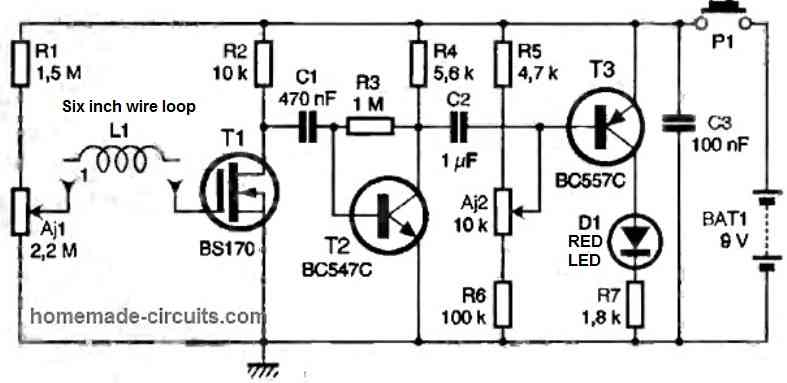The assembly proposed in these lines is an electromagnetic radiation detector (power and others) that allows the user to organize their living space with full knowledge.
Circuit Description
The sensor used for this design is a simple wire coil (L1) associated with the MOSFET transistor (T1) biased at the beginning of its conduction zone by the tandem R1, AJ1.


The frequency of the EMF induced in the coil L1 is recovered at the drain of T1 and strongly amplified. The signals thus amplified at the terminals of R2 are capacitively transmitted by capacitor C1 to a second common emitter amplifier stage, built around the NPN bipolar reference transistor T2.
The amplitude of the signal present on the collector of T2 depends not only on the intensity of the ambient radiation, but levels of over 100 mV have been recorded during tests near the oscilloscope used for measurement. Capacitor C2 provides the connection to the third and last transistor amplifier stage.
The base of T3 is biased by R5, R6 and the adjustable AJ2, which must be adjusted so that T3 is at the limit of blocking in the absence of radiation, thus causing the extinction of the LED D1 placed in the collector circuit.
In the presence of any radiation, the negative alternations of the signal recovered at the terminals of R4 cause the conduction of T3 and therefore the lighting of LED D1. Resistance R7 limits the direct current passing through the LED diode.
Since this assembly is only used occasionally and for the necessary duration to diagnose contaminated areas, a simple push-button switch (P1) serves as an ON/OFF switch. The decoupling of the power supply (a 9V 6F22 type battery) is ensured by C3.
Testing and tuning
To become operational, our detector requires two simple adjustments to be made.
First of all, it is necessary to place oneself in an area that is not (or little) disturbed by radiation, such as the center of a room, at a respectable distance from any electrical connection, including lighting, or preferably outside a dwelling and at a distance from any high voltage line.
After checking the correct orientation of the transistors and LED D1, AJ1 will be placed in the clockwise direction and the module will be powered under 9 V, taking care to temporarily short-circuit the P1 push button so as not to have to keep it pressed during the adjustments.
By turning the adjustable AJ2 alternately in both directions, one should go from the state of the LED being lit to the state of the "LED off." The correct adjustment for AJ2 is the one that corresponds to the state of the "LED almost off."
Using a high-brightness transparent package LED, one should barely see a reddish zone when looking at it from the front.
To adjust AJ1, it is now necessary to bring our module (a few centimeters) close to a source of radiation: a plastic wall socket, a television, a hi-fi system, the power cord of a bedside lamp, etc.
By turning AJ1 counterclockwise, it will be noted that for a particular setting, LED D1 lights up more intensely the closer one gets to the source of radiation.
By making small successive adjustments, one should arrange for the LED to start shining as far away as possible from the radiation source without remaining lit permanently when moving away from it, which would correspond to the permanent conduction of T1, and thus to a bad adjustment of AJ1.
This adjustment stage is more or less delicate, but within the reach of any amateur electronics enthusiast.
When the adjustable AJ1 is correctly adjusted, the detector is operational. You can then survey your immediate environment. We have personally observed that the detector reacted strongly to the approach of video or computer equipment even when we were still more than a meter away.
Clear detections were also observed at more than 40 cm from an alarm clock (now moved away from the head of the bed) and at 20 cm for the power cords of bedside lamps.
More surprisingly, for a chandelier under power, whose radiation was detected at more than 1.20 m even though it had no insulation defects after checking. We have observed the beneficial effect of the metallic shielding (connected to ground) of washing machines in service, whose radiation at a few centimeters was almost zero.
Since this home electromagnetic radiation detector circuit systematically reacts to the proximity of live wires, it can also be used to determine whether a socket or equipment, such as an electrical panel on which work is to be done, is indeed de-energized.
In this latter case, it may be interesting to replace push button P1 with a switch to ensure, throughout the intervention, that power is absent from the equipment in question without having to hold down the button.
There is no doubt that this small circuit will find a place in your measuring equipment and that you will find many opportunities to make it useful.
Sir, can treasure be found with this detector??
Hello Sir. Thank you so much. Now, why is T3 used as a complementary transistor to T2? Is it not possible for both to be NPN transistors?
Hi Jedidiah,
If NPN is used for T3 it wouldn’t amplify the T2 signals, rather just invert the T2 signals, whereas a PNP for T3 complements the T2 signals and amplifies it further to much higher levels.
Thank you.
R3 (1M) is connected as a feedback. Is there any significant effect on the circuit’s operation when it’s directly connected to Vcc?
The transistor T2 along with R3 are configured to work like a preamplifier, so the R3 must be connected at the exact position where it is shown, if it is linked with the Vcc the T2 preamplifier will stop working.